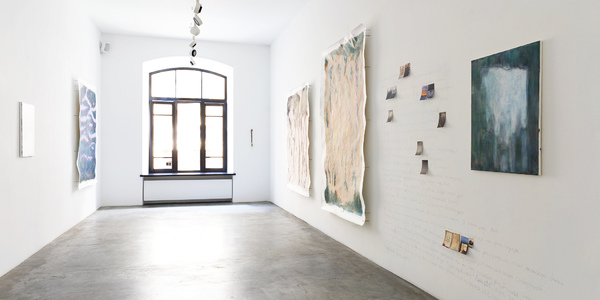Saplīsa Krūms
Petr Kirusha
27.05.2021 – 25.07.2021
Petr Kirusha's solo exhibition «Saplīsa Krūms» carries on a series of collaborative projects by a St. Petersburg-based MYTH Gallery and a Moscow-based Iragui Gallery. Their first joint project was arranged at Iragui in January through March, showcasing Liza Bobkova’s ‘I See a Catastrophe All the Time I Sleep.’ Now, MYTH is playing the host side, featuring new works of an artist acknowledged at the international art scene.
The project sums up one person’s relations with chaos. On the one hand, chaos stands for absolute freedom, and on the other – for no specific boundaries, in particular, as a person’s self is regarded. Today, decades after the ninetees and noughties we still can’t help but romanticize all their chaos and freedom. Is it possible that we are no longer capable of challenging the society, questioning the existing world view, and call ourselves in the name of freedom?
According to the artist, our today is “a state when you stay somewhere comfortable watching things going on outside. You can’t or don’t want to be out there, but still you’re curios.” This implies building of new relations both with chaos and freedom, and a series of paintings at the exhibition tell about that – and so does a group of micro-novels featuring some cartography of impressions the artist has experienced in the recent years.
The landscape series images a human-chaos interaction. Our ‘self’ is a kind of eyelids that we do not notice while peering out of the window or over the fence. Unbounded lands that belong to nobody beckon with freedom and yet scare us with their foreignness. An invisible actor tries to deal with chaos by locating networks of fences, streets, and paths, identifying him-/herself through borders and contours, and presenting his/her self to the audience. A flickering contour encloses some of the space. It narrows, vanishes – and then reappears once again, featuring the fundamental difference between paper and canvas. It is all about the number of extensions and compression, the amount of layers. Here, freedom is not about infinite filling of the space but about being able to make innumerable mistakes and then restart all over in a new way. It is the same with nobody’s land – as soon as it becomes someone’s we can no longer use it in any other way. People portrayed by Petr Kirusha never look themselves, as the artist images not their generalized character but only one of the versions of their selves.
The series of works about mushrooms and France are brought together under a single story about local citizens making their first steps towards evolution in the nobody’s lands – the woods, learning first hand which mushrooms were edible and which were not. Populations of people and mushrooms began to interact once again having overcome the cultural divide. Symbiotic systems existing in regular conditions for a long term – just like man-made spaces like cities or farmlands are spreading throughout the Earth and are seen in landscapes as lines. Meanwhile, they are more likely to resemble dots in case of an emerging civilization.
One of the novels explains the origin of the name «Saplīsa Krūms» (A Smashed Bush). In Latvian, ‘saplīsa krūms’ is a collocation that is not a language norm and thus has a half-understandable meaning. Such language constructs are a chora – a linguistic nobody’s land (initially, the Greek word χώρα stood for gardens and patches that residents of ancient polis held out of town). These refer to myriads of words and collocations we invent that can’t wait to get a meaning and at the same time keep fading from our memories.
Art, politics, and ourselves – everything is determined through our relations with chaos. These relations are changing continuously, shaping increasingly more new fields of thinking and experience, as if we are treading our ways through the woods. But how wide should the treaded paths be for the woods not to extinct? How much freedom does a person need – and how much order? This is the question everyone has to answer on their own, and it is the same with perceiving art. And everything keeps changing as time goes.
Alexander Jouravlev








